Water Quality Focusing on the Hellenic World: From Ancient to Modern Times and the Future
Abstract
:1. Introduction
The history of water is equivalent to the history of the world and the history of water quality is equivalent to the history of life.(Andreas N. Angelakis)
2. Water Quality in Prehistoric to Medieval Times (ca. 3200 BC–1400 AD)
2.1. Prehistoric Times (ca. 3200–1100 BC)
2.2. Iron Times (ca. 1100–750 BC)
2.3. Historical Times (ca. 750 BC–476 AD)
2.3.1. Archaic Period (ca. 750–480 BC)
2.3.2. Classical and Hellenistic Periods (ca. 480–31 BC)
2.3.3. Roman Period
2.4. Medieval Times (ca. 476–1400 AD)
3. Water Quality in Early and Midmodern Times (ca.1400–1900 AD)
4. Water Quality in Contemporary Times (1900 AD-Present)
- (a)
- Eutrophication. Not well understood at first. Richard Vollenweider [32] in the late 1960s was credited with making the connection between eutrophication and nutrients.
- (b)
- Aging water treatment facilities. Most facilities were built in the 1920s and 1930s; they reached their design age by the 1950s and provided the impetus to upgrade many facilities.
- (c)
- Water shortages start emerging partially due to pollution problems. New legislation often focused on preserving water quality to increase supply.
5. Water Quality: Emerging Trends and Future Issues and Challenges
5.1. Water Quality and Water Scarcity
5.2. Water Quality and Use of Nonconventional Water Resources
5.3. Water Quality and Emerging Pollutants/Contaminants (e.g., Pathogens, Pharmaceuticals, and Microplastics)
6. Conclusions
- Revisit and recognize the chronological evolution of water quality technologies as an essential guarantee against water quality and life preservation through the ages;
- Revise water resource management programs within an integrated and holistic approach where local and regional-scale particularities and needs are considered in the context of a long-term water management strategy;
- Consider nonconventional water resources even for potable use (e.g., water reuse, rainwater harvesting, stormwater utilization, and desalination), particularly in climate change/water scarcity vulnerable and/or rapidly and densely growing areas (e.g., megacities) as a mean to increase water availability and protect the sustainability of natural resources;
- Consider and remove the old and new emerging pollutants and contaminants (e.g., antibiotics and microplastics) by updating the current water and wastewater treatment technologies;
- Include nonconventional water resources within a cyclic model of water use in agreement with the requirements of the circular bioeconomy concept;
- Provide links between climate change and water quality; it is required to understand how climate change alters the precipitation and temperature patterns and how these changing climate parameters influence the transfer and spreading of pollutants/contaminants to water bodies and even to biodiversity and humans;
- Change the scale of our view regarding the interplay between climate and water quality, from the local one to a broader (global) view and improve climate and water quality monitoring in space and time (use of commonly accepted methodologies and a set of representative water quality parameters);
- An alternative may include the so-called “risk management focus”, which consists of proactively aiming at preventing and mitigating drought impact. These measures focus on identifying the sources of vulnerability (sectors, regions, communities, or population groups) to implement mitigation and adaptation actions to future droughts.
Author Contributions
Funding
Institutional Review Board Statement
Informed Consent Statement
Data Availability Statement
Conflicts of Interest
References
- Mays, L.W. A brief history of water filtration/sedimentation. Water Supply 2013, 13, 735–742. [Google Scholar] [CrossRef]
- Kosso, C.; Scott, A. The Nature and Function of Water, Baths, Bathing, and Hygiene from Antiquity through the Renaissance; Brill: Leiden, The Netherlands, 2009; Volume 11. [Google Scholar]
- Zarkadoulas, N.; Koutsoyiannis, D.; Mamassis, N.; Papalexiou, S. Climate, water and health in ancient Greece. In Climate, Water and Health in Ancient Greece; European Geosciences Union General Assembly, Ed.; European Geosciences Union: Munich, Germany, 2008; p. 10. [Google Scholar]
- Angelakis, A.; Koutsoyiannis, D.; Tchobanoglous, G. Urban wastewater and stormwater technologies in ancient Greece. Water Res. 2005, 39, 210–220. [Google Scholar] [CrossRef] [PubMed]
- Koutsoyiannis, D.; Patrikiou, A.; Ostigard, T. Water control in Ancient Greek cities. Water Urban. 2013, 130–148. [Google Scholar]
- Angelakis, A.; Voudouris, K.; Tchobanoglous, G. Evolution of water supplies in the Hellenic world focusing on water treatment and modern parallels. Water Supply 2020, 20, 773–786. [Google Scholar] [CrossRef]
- Mays, L.W.; Sklivaniotis, M.; Angelakis, A.N. Water for human consumption through the History. In Evolution of Water Supply through the Millennia; Angelakis, A.N., Mays, L., Eds.; IWA Publishing: London, UK, 2014; Chapter 2; pp. 19–42. [Google Scholar]
- De Feo, G.; Mays, L.; Angelakis, A. Water and wastewater management technologies in the ancient Greek and Roman civilizations. In Water-Quality Engineering; Elsevier: Amsterdam, The Netherlands, 2011; pp. 3–22. [Google Scholar]
- Angelakis, A.N.; Vuorinen, H.S.; Nikolaidis, C.; Juuti, P.S.; Katko, T.S.; Juuti, R.P.; Zhang, J.; Samonis, G. Water quality and life expectancy: Parallel courses in time. Water 2021, 13, 752. [Google Scholar] [CrossRef]
- Angelakis, A.N.; Spyridakis, S.V. The status of water resources in Minoan times—A preliminary study. In Diachronic Climatic Impacts on Water Resources with Emphasis on Mediterranean Region; Angelakis, A., Issar, A., Eds.; Springer-Verlag: Heidelberg, Germany, 1996; pp. 161–191. [Google Scholar]
- Smith, V.S. Clean: A History of Personal Hygiene and Purity; Oxford University Press: Oxford, UK, 2008; p. 457. [Google Scholar]
- Ashenburg, K. The Dirt on Clean: An Unsanitized History; North Point Press: New York, NY, USA, 2010; p. 368. [Google Scholar]
- Juuti, P.S.; Katko, T.; Vuorinen, H. Environmental History of Water; IWA Publishing: London, UK, 2007. [Google Scholar]
- Angelakis, A. Evolution of rainwater harvesting and use in Crete, Hellas, through the millennia. Water Sci. Technol. Water Supply 2016, 16, 1624–1638. [Google Scholar] [CrossRef]
- Krasilnikoff, J.; Angelakis, A.N. Water management and its judicial contexts in ancient Greece: A review from the earliest times to the Roman period. Water Policy 2019, 21, 245–258. [Google Scholar] [CrossRef]
- Khan, S.; Dialynas, E.; Kasaraneni, V.; Angelakis, A. Similarities of Minoan and Indus Valley hydro-technologies. Sustainability 2020, 12, 4897. [Google Scholar] [CrossRef]
- Baker, M.N.; Taras, M.J. The Quest for Pure Water: The History of Water Purification from the Earliest Records to the Twentieth Century, 2nd ed.; American Water Works Association: Denver, CO, USA, 1981; Volume 1–2. [Google Scholar]
- Sklivaniotis, M.; Angelakis, A. Historical development of the treatment of potable water. In Proceedings of the 1st IWA International Symposium on Water and Wastewater Technologies in Ancient Civilizations, Iraklion, Greece, 28–30 October 2006; pp. 659–666. [Google Scholar]
- Defner, M. Late Minoan water treatment device. Archaeol. Newsp. 1921, 8. [Google Scholar]
- Vuorinen, H.S. Water and Health in Antiquity: Europe’s Legacy. In Environmental History of Water—Global Views on Community Water Supply and Sanitation; Juuti, P., Katko, T., Vuorinen, H., Eds.; IWA Publishing: London, UK, 2007; pp. 45–67. [Google Scholar]
- Angelakis, A.N.; Antoniou, G.P.; Yapijakis, C.; Tchobanoglous, G. History of Hygiene Focusing on the Crucial Role of Water in the Hellenic Asclepieia (i.e., Ancient Hospitals). Water 2020, 12, 754. [Google Scholar] [CrossRef] [Green Version]
- Klingborg, P.; Finné, M. Modelling the freshwater supply of cisterns in ancient Greece. Water Hist. 2018, 10, 113–131. [Google Scholar] [CrossRef] [Green Version]
- Angelakis, A.N.; Valipour, M.; Ahmed, A.T.; Tzanakakis, V.; Paranychianakis, N.V.; Krasilnikoff, J.; Drusiani, R.; Mays, L.; El Gohary, F.; Koutsoyiannis, D. Water conflicts: From ancient to modern times and in the future. Sustainability 2021, 13, 4237. [Google Scholar] [CrossRef]
- Yapijakis, C. Athenian Plague and Coronavirus; Newspaper the VIMA 6/04/2020: Athens, Greece, 2020. (In Greek) [Google Scholar]
- Enzler, S. History of Water Treatment. 1998. Available online: www.lenntech.com/history-wtare-treatment.htm (accessed on 1 June 2022).
- Al-Shaar, M. Water Sterilization Technology in Muslim Civilization. Muslim Heritage. Available online: https://muslimheritage.com/water-sterilization-technology/ (accessed on 1 June 2022).
- Rogers, J.R. Environmental and Water Resources; American Society of Civil Engineers: Reston, VA, USA, 2007. [Google Scholar]
- Foil, J.L.; Cerwick, J.A.; White, J.E. Collection systems past and present. In Water Environment and Technology; Water Environment Federation: Alexandria, VA, USA, 1993. [Google Scholar]
- Panagiotakis, N.; Angelakis, A.; Koutsoyiannis, D. Water management in the pediada region in central crete through time. In Proceedings of the 1st IWA International Symposium on Water and Wastewater Technologies in Ancient Civilizations, National Fountation for Agricultural Research, Institute of Iraklion, Iraklion, Greece, 28–30 October 2006; pp. 271–280. [Google Scholar]
- Spanakis, S. The Water Supply of Iraklion; The Technical Chamber of Greece Dept. of Eastern Crete: Iraklion, Greece, 1981; pp. 828–1939. [Google Scholar]
- Yannopoulos, S.; Antoniou, G.; Kaiafa-Saropoulou, M.; Angelakis, A. Historical development of rainwater harvesting and use in Hellas: A preliminary review. Water Sci. Technol. Water Supply 2017, 17, 1022–1034. [Google Scholar] [CrossRef]
- Mosello, R.; de Bernadi, R.; Ravera, O.; Richard, A. Vollenweider: Contribution to our knowledge of Italian lakes. Aquat. Ecosyst. Health Manag. 2011, 14, 174–178. [Google Scholar] [CrossRef]
- Kramek, N.; Loh, L. The History of Philadelphia’s Water Supply and Sanitation System. Lessons in Sustainability of Developing Urban Water Systems. Master’s Thesis, University of Pennsylvania, Philadelphia, PA, USA, 2007. [Google Scholar]
- Directive, E. Council Directive of 21. May 1991 concerning urban waste water treatment (91/271/EEC). J. Eur. Commun 1991, 34, 40. [Google Scholar]
- Directive, C. Concerning the protection of waters against pollution caused by nitrates from agricultural sources. Off. No J. Eur. Communities 1991, 375. Available online: https://eur-lex.europa.eu/legal-content/EN/TXT/PDF/?uri=CELEX:31991L0676 (accessed on 10 June 2022).
- CMD. Common Ministerial Decision. In Management Plan as a River Basin of the Water Region of Crete; No 163; ΦΕΚ 570/B’/2015; Ministry of Environment, Energy and Climate Change: Athens, Greece, 2015. (In Greek) [Google Scholar]
- EC-COM. European Commission. Proposal for a Regulation of the European Parliament and of the Council on on Minimum Requirements for Water Reuse (337 final). Available online: ec.europa.eu/environment/water/reuse.htm (accessed on 1 June 2018).
- CMD. Common Ministerial Decision. In Management Plan as a River Basin of the Water Region of Crete; No 896; ΦΕΚ Β/4666/2017; Ministry of Environment, Energy and Climate Change: Athens, Greece, 2017. (In Greek) [Google Scholar]
- CMD. Common Ministerial Decision. In Measures, Limits and Procedures for Reuse of Treated Wastewater; No. 145116; Ministry of Environment, Energy and Climate Change: Athens, Greece, 2011. (In Greek) [Google Scholar]
- US-EPA. History of the Clean Water Act. Available online: https://www.epa.gov/laws-regulations/history-clean-water-act (accessed on 10 June 2022).
- Control CfD, Prevention. A century of US water chlorination and treatment: One of the ten greatest public health achievements of the 20th century. MMWR. Morb. Mortal. Wkly. Rep. 1999, 48, 621–629. [Google Scholar]
- Dietrich, A.M. Aesthetic issues for drinking water. J. Water Health 2006, 4, 11–16. [Google Scholar] [CrossRef] [Green Version]
- Reiter, P. Imperatives for urban water professionals on the pathway to 2050: Adapting to rapidly changing conditions on a crowder planet. Int. Water Assoc. Water Her. Learn Your Peers 2012, 4, 6–8. [Google Scholar]
- Kotzamanis, V. The Evolution of the Life Expectancy of the Greeks; University of Thessaly: Volos, Greece, 2010; Available online: https://www.flash.gr/tech/1112142/i-exelixi-toy-prosdokimoy-zwis-twn-ellinwn (accessed on 1 June 2022).
- Anonymous. To 2020, Life Expectancy Fell More than Any Other Year after World War II (In Greek). Available online: https://www.amna.gr/health/article/588471/To-2020--to-prosdokimo-zois-meiothike-perissotero-apo-kathe-alli-chronia-meta-ton-B-Pagkosmio-Polemo- (accessed on 1 March 2021).
- Angelopoulou, A. The life expectancy of Greeks is a little higher than that of EU citizens. In Newspaper Naftemporiki; Ζοfrank Holdings Co. Ltd.: Athens, Greece, 28 January 2020. (In Greek) [Google Scholar]
- Desa, U. World Population Prospects 2019: Highlights. New York (US); United Nations Department for Economic and Social Affairs: New York, NY, USA, 2019; Volume 11, p. 125. [Google Scholar]
- WHO. Our Mission. Available online: https://wholives.org/our-mission/mission/# (accessed on 1 June 2022).
- Mishra, B.K.; Kumar, P.; Saraswat, C.; Chakraborty, S.; Gautam, A. Water security in a changing environment: Concept, challenges and solutions. Water 2021, 13, 490. [Google Scholar] [CrossRef]
- Schwarzenbach, R.P.; Egli, T.; Hofstetter, T.B.; Von Gunten, U.; Wehrli, B. Global water pollution and human health. Annu. Rev. Environ. Resour. 2010, 35, 109–136. [Google Scholar] [CrossRef]
- Tzanakakis, V.A.; Paranychianakis, N.V.; Angelakis, A.N. Water Supply and Water Scarcity. Water 2020, 12, 2347. [Google Scholar] [CrossRef]
- van Vliet, M.T.; Jones, E.R.; Flörke, M.; Franssen, W.H.; Hanasaki, N.; Wada, Y.; Yearsley, J.R. Global water scarcity including surface water quality and expansions of clean water technologies. Environ. Res. Lett. 2021, 16, 024020. [Google Scholar] [CrossRef]
- Brooks, B.W.; Lazorchak, J.M.; Howard, M.D.; Johnson, M.V.V.; Morton, S.L.; Perkins, D.A.; Reavie, E.D.; Scott, G.I.; Smith, S.A.; Steevens, J.A. Are harmful algal blooms becoming the greatest inland water quality threat to public health and aquatic ecosystems? Environ. Toxicol. Chem. 2016, 35, 6–13. [Google Scholar] [CrossRef]
- Carr, G.M.; Neary, J.P. Water Quality for Ecosystem and Human Health; UNEP/Earthprint: Nairobi, Kenya, 2008. [Google Scholar]
- Cramer, W.; Guiot, J.; Fader, M.; Garrabou, J.; Gattuso, J.-P.; Iglesias, A.; Lange, M.A.; Lionello, P.; Llasat, M.C.; Paz, S. Climate change and interconnected risks to sustainable development in the Mediterranean. Nat. Clim. Chang. 2018, 8, 972–980. [Google Scholar] [CrossRef] [Green Version]
- Kloos, J.; Gebert, N.; Rosenfeld, T.; Renaud, F. Climate change, water conflicts and human security. In Regional Assessment and Policy Guidelines for the Mediterranean, Middle East and Sahel; CLICO Final Report; UNited Nations University–Institute for Environment and Human Security (Report, 10): Bonn, Germany, 2013. [Google Scholar]
- Cissé, G. Food-borne and water-borne diseases under climate change in low-and middle-income countries: Further efforts needed for reducing environmental health exposure risks. Acta Trop. 2019, 194, 181–188. [Google Scholar] [CrossRef]
- Semenza, J.C.; Herbst, S.; Rechenburg, A.; Suk, J.E.; Höser, C.; Schreiber, C.; Kistemann, T. Climate change impact assessment of food-and waterborne diseases. Crit. Rev. Environ. Sci. Technol. 2012, 42, 857–890. [Google Scholar] [CrossRef] [Green Version]
- Michalak, A.M. Study role of climate change in extreme threats to water quality. Nature 2016, 535, 349–350. [Google Scholar] [CrossRef]
- Tzanakakis, V.; Angelakis, A.; Paranychianakis, N.; Dialynas, Y.; Tchobanoglous, G. Challenges and Opportunities for Sustainable Management of Water Resources in the Island of Crete, Greece. Water 2020, 12, 1538. [Google Scholar] [CrossRef]
- Paranychianakis, N.; Salgot, M.; Snyder, S.; Angelakis, A. Quality criteria for recycled wastewater effluent in EU-countries: Need for a uniform approach. Crit. Rev. Environ. Sci. Technol. 2015, 45, 1409–1468. [Google Scholar] [CrossRef]
- Tchobanoglous, G. Integrated wastewater management: The future of water reuse in large metropolitan areas. Integr. Environ. Assess. Manag. 2019, 15, 160–163. [Google Scholar] [CrossRef] [PubMed] [Green Version]
- Angelakis, A.N.; Valipour, M.; Choo, K.-H.; Ahmed, A.T.; Baba, A.; Kumar, R.; Toor, G.S.; Wang, Z. Desalination: From Ancient to Present and Future. Water 2021, 13, 2222. [Google Scholar] [CrossRef]
- Voutchkov, N. Energy use for membrane seawater desalination–current status and trends. Desalination 2018, 431, 2–14. [Google Scholar] [CrossRef]
- Demetropoulou, L.; Lilli, M.A.; Petousi, I.; Nikolaou, T.; Fountoulakis, M.; Kritsotakis, M.; Panakoulia, S.; Giannakis, G.V.; Manios, T.; Nikolaidis, N.P. Innovative methodology for the prioritization of the Program of Measures for integrated water resources management of the Region of Crete, Greece. Sci. Total Environ. 2019, 672, 61–70. [Google Scholar] [CrossRef]
- Praveen, P.K.; Ganguly, S.; Wakchaure, R.; Para, P.A.; Mahajan, T.; Qadri, K.; Kamble, S.; Sharma, R.; Shekhar, S.; Dalai, N. Water-borne diseases and its effect on domestic animals and human health: A Review. Int. J. Emerg. Technol. Adv. Eng. 2016, 6, 242–245. [Google Scholar]
- Saravanan, V.; Ayessa Idenal, M.; Saiyed, S.; Saxena, D.; Gerke, S. Urbanization and human health in urban India: Institutional analysis of water-borne diseases in Ahmedabad. Health Policy Plan. 2016, 31, 1089–1099. [Google Scholar] [CrossRef] [Green Version]
- Fenwick, A. Waterborne Infectious Diseases Could They Be Consigned to History? Science 2006, 313, 1077–1081. [Google Scholar] [CrossRef] [Green Version]
- Adegoke, A.A.; Amoah, I.D.; Stenström, T.A.; Verbyla, M.E.; Mihelcic, J.R. Epidemiological evidence and health risks associated with agricultural reuse of partially treated and untreated wastewater: A review. Front. Public Health 2018, 337. [Google Scholar] [CrossRef] [Green Version]
- Malik, A.; Yasar, A.; Tabinda, A.; Abubakar, M. Water-borne diseases, cost of illness and willingness to pay for diseases interventions in rural communities of developing countries. Iran. J. Public Health 2012, 41, 39. [Google Scholar]
- Dare, A.M.; Ayinde, I.A.; Shittu, A.M.; Sam-Wobo, S.O.; Akinbode, S.O. Determinants of Cost of Treating Water-Borne Diseases Among Rural Households in South West Nigeria. J. Adv. Dev. Econ. 2019, 1, 26–38. [Google Scholar] [CrossRef] [Green Version]
- Lu, Y.; Song, S.; Wang, R.; Liu, Z.; Meng, J.; Sweetman, A.J.; Jenkins, A.; Ferrier, R.C.; Li, H.; Luo, W. Impacts of soil and water pollution on food safety and health risks in China. Environ. Int. 2015, 77, 5–15. [Google Scholar] [CrossRef] [PubMed] [Green Version]
- Royston, M.G. Pollution Prevention Pays; Elsevier: Amsterdam, The Netherlands, 2013. [Google Scholar]
- Plowright, R.K.; Sokolow, S.H.; Gorman, M.E.; Daszak, P.; Foley, J.E. Causal inference in disease ecology: Investigating ecological drivers of disease emergence. Front. Ecol. Environ. 2008, 6, 420–429. [Google Scholar] [CrossRef] [Green Version]
- Cohen, J.M.; Civitello, D.J.; Brace, A.J.; Feichtinger, E.M.; Ortega, C.N.; Richardson, J.C.; Sauer, E.L.; Liu, X.; Rohr, J.R. Spatial scale modulates the strength of ecological processes driving disease distributions. Proc. Natl. Acad. Sci. 2016, 113, E3359–E3364. [Google Scholar] [CrossRef] [PubMed] [Green Version]
- Brubacher, J.; Allen, D.M.; Déry, S.J.; Parkes, M.W.; Chhetri, B.; Mak, S.; Sobie, S.; Takaro, T.K. Associations of five food-and water-borne diseases with ecological zone, land use and aquifer type in a changing climate. Sci. Total Environ. 2020, 728, 138808. [Google Scholar] [CrossRef]
- Smith, B.; Fazil, A. Climate change and infectious diseases: The challenges: How will climate change impact microbial foodborne disease in Canada? Can. Commun. Dis. Rep. 2019, 45, 108. [Google Scholar] [CrossRef]
- Karkman, A.; Do, T.T.; Walsh, F.; Virta, M.P. Antibiotic-resistance genes in waste water. Trends Microbiol. 2018, 26, 220–228. [Google Scholar] [CrossRef] [Green Version]
- Suárez, S.; Carballa, M.; Omil, F.; Lema, J.M. How are pharmaceutical and personal care products (PPCPs) removed from urban wastewaters? Rev. Environ. Sci. Bio/Technol. 2008, 7, 125–138. [Google Scholar] [CrossRef]
- Anastopoulos, I.; Pashalidis, I.; Kayan, B.; Kalderis, D. Microplastics as carriers of hydrophilic pollutants in an aqueous environment. J. Mol. Liq. 2022, 350, 118182. [Google Scholar] [CrossRef]
- Baho, D.L.; Bundschuh, M.; Futter, M.N. Microplastics in terrestrial ecosystems: Moving beyond the state of the art to minimize the risk of ecological surprise. Glob. Change Biol. 2021, 27, 3969–3986. [Google Scholar] [CrossRef]
- Ebele, A.J.; Abdallah, M.A.-E.; Harrad, S. Pharmaceuticals and personal care products (PPCPs) in the freshwater aquatic environment. Emerg. Contam. 2017, 3, 1–16. [Google Scholar] [CrossRef]
- Eerkes-Medrano, D.; Thompson, R.C.; Aldridge, D.C. Microplastics in freshwater systems: A review of the emerging threats, identification of knowledge gaps and prioritisation of research needs. Water Res. 2015, 75, 63–82. [Google Scholar] [CrossRef] [PubMed]
- Tan, D.T.; Shuai, D. Research highlights: Antibiotic resistance genes: From wastewater into the environment. Environ. Sci. Water Res. Technol. 2015, 1, 264–267. [Google Scholar] [CrossRef]
- Voulvoulis, N. Water reuse from a circular economy perspective and potential risks from an unregulated approach. Curr. Opin. Environ. Sci. Health 2018, 2, 32–45. [Google Scholar] [CrossRef]
- Xie, J.; Jin, L.; He, T.; Chen, B.; Luo, X.; Feng, B.; Huang, W.; Li, J.; Fu, P.; Li, X. Bacteria and Antibiotic Resistance Genes (ARGs) in PM2.5 from China: Implications for Human Exposure. Environ. Sci. Technol. 2019, 53, 963–972. [Google Scholar] [CrossRef] [PubMed]
- Keerthanan, S.; Jayasinghe, C.; Biswas, J.K.; Vithanage, M. Pharmaceutical and Personal Care Products (PPCPs) in the environment: Plant uptake, translocation, bioaccumulation, and human health risks. Crit. Rev. Environ. Sci. Technol. 2021, 51, 1221–1258. [Google Scholar] [CrossRef]
- Kim, D.; Kwak, J.I.; An, Y.-J. Effects of bisphenol A in soil on growth, photosynthesis activity, and genistein levels in crop plants (Vigna radiata). Chemosphere 2018, 209, 875–882. [Google Scholar] [CrossRef]
- Kwak, J.I.; Moon, J.; Kim, D.; An, Y.-J. Soil ecotoxicity of seven endocrine-disrupting chemicals: A review. Eur. J. Soil Sci. 2017, 68, 621–649. [Google Scholar] [CrossRef]
- Voutsa, D.; Hartmann, P.; Schaffner, C.; Giger, W. Benzotriazoles, alkylphenols and bisphenol A in municipal wastewaters and in the Glatt River, Switzerland. Environ. Sci. Pollut. Res. Int. 2006, 13, 333–341. [Google Scholar] [CrossRef] [Green Version]
- Arditsoglou, A.; Voutsa, D. Occurrence and partitioning of endocrine-disrupting compounds in the marine environment of Thermaikos Gulf, Northern Aegean Sea, Greece. Mar. Pollut. Bull. 2012, 64, 2443–2452. [Google Scholar] [CrossRef]
- Zerva, I.; Alexandropoulou, I.; Panopoulou, M.; Melidis, P.; Ntougias, S. Antibiotic Resistance Genes Dynamics at the Different Stages of the Biological Process in a Full-Scale Wastewater Treatment Plant. Proceedings 2018, 2, 650. [Google Scholar] [CrossRef] [Green Version]
- Yang, Y.; Song, W.; Lin, H.; Wang, W.; Du, L.; Xing, W. Antibiotics and antibiotic resistance genes in global lakes: A review and meta-analysis. Environ. Int. 2018, 116, 60–73. [Google Scholar] [CrossRef] [PubMed] [Green Version]
- Rizzo, L.; Manaia, C.; Merlin, C.; Schwartz, T.; Dagot, C.; Ploy, M.C.; Michael, I.; Fatta-Kassinos, D. Urban wastewater treatment plants as hotspots for antibiotic resistant bacteria and genes spread into the environment: A review. Sci. Total Environ. 2013, 447, 345–360. [Google Scholar] [CrossRef] [PubMed] [Green Version]
- Malakar, A.; Snow, D.D.; Ray, C. Irrigation water quality—A contemporary perspective. Water 2019, 11, 1482. [Google Scholar] [CrossRef] [Green Version]
- Sabri, N.A.; Schmitt, H.; Van der Zaan, B.; Gerritsen, H.W.; Zuidema, T.; Rijnaarts, H.H.M.; Langenhoff, A.A.M. Prevalence of antibiotics and antibiotic resistance genes in a wastewater effluent-receiving river in the Netherlands. J. Environ. Chem. Eng. 2018, 8, 102245. [Google Scholar] [CrossRef]
- Al Salah, D.M.M.; Laffite, A.; Poté, J. Occurrence of Bacterial Markers and Antibiotic Resistance Genes in Sub-Saharan Rivers Receiving Animal Farm Wastewaters. Sci. Rep. 2019, 9, 14847. [Google Scholar] [CrossRef]
- Pazda, M.; Kumirska, J.; Stepnowski, P.; Mulkiewicz, E. Antibiotic resistance genes identified in wastewater treatment plant systems—A review. Sci. Total Environ. 2019, 697, 134023. [Google Scholar] [CrossRef]
- Geyer, R.; Jambeck, J.R.; Law, K.L. Production, use, and fate of all plastics ever made. Sci. Adv. 2017, 3, e1700782. [Google Scholar] [CrossRef] [Green Version]
- Helmberger, M.S.; Tiemann, L.K.; Grieshop, M.J. Towards an ecology of soil microplastics. Funct. Ecol. 2020, 34, 550–560. [Google Scholar] [CrossRef] [Green Version]
- Issac, M.N.; Kandasubramanian, B. Effect of microplastics in water and aquatic systems. Environ. Sci. Pollut. Res. 2021, 28, 19544–19562. [Google Scholar] [CrossRef]
- Enfrin, M.; Dumée, L.F.; Lee, J. Nano/microplastics in water and wastewater treatment processes–origin, impact and potential solutions. Water Res. 2019, 161, 621–638. [Google Scholar] [CrossRef]
- Gong, J.; Xie, P. Research progress in sources, analytical methods, eco-environmental effects, and control measures of microplastics. Chemosphere 2020, 254, 126790. [Google Scholar] [CrossRef] [PubMed]
- Li, J.; Song, Y.; Cai, Y. Focus topics on microplastics in soil: Analytical methods, occurrence, transport, and ecological risks. Environ. Pollut. 2020, 257, 113570. [Google Scholar] [CrossRef] [PubMed]
- Zhou, Y.; Wang, J.; Zou, M.; Jia, Z.; Zhou, S.; Li, Y. Microplastics in soils: A review of methods, occurrence, fate, transport, ecological and environmental risks. Sci. Total Environ. 2020, 748, 141368. [Google Scholar] [CrossRef]
- Kinigopoulou, V.; Pashalidis, I.; Kalderis, D.; Anastopoulos, I. Microplastics as carriers of inorganic and organic contaminants in the environment: A review of recent progress. J. Mol. Liq. 2022, 350, 118580. [Google Scholar] [CrossRef]
- Li, J.; Zhang, K.; Zhang, H. Adsorption of antibiotics on microplastics. Environ. Pollut. 2018, 237, 460–467. [Google Scholar] [CrossRef] [PubMed]
- Spyridakis, I.; Tzanakakis, V.A.; Pashalidis, I.; Kalderis, D.; Anastopoulos, I. Polyamide nylon 6 as a potential carrier of nitrate anions in aqueous environments. J. Mol. Liq. 2022, 352, 118706. [Google Scholar] [CrossRef]
- Tsitsifli, S.; Kanakoudis, V. Disinfection impacts to drinking water safety—A review. Multidiscip. Digit. Publ. Inst. Proc. 2018, 2, 603. [Google Scholar]
- World Health Organization (WHO). Guidelines for Drinking-Water Quality: Incorporating the First and Second Addenda; World Health Organization (WHO): Geneva Switzerland, 2022.
- Aburto, J.M.; Villavicencio, F.; Basellini, U.; Kjærgaard, S.; Vaupel, J.W. Dynamics of life expectancy and life span equality. Proc. Natl. Acad. Sci. 2020, 117, 5250–5259. [Google Scholar] [CrossRef] [Green Version]
- Parker, C.B. Stanford Research Cites Child Mortality as Major Factor in Lifespan Inequality Gap. Stanford News. Available online: https://news.stanford.edu/2016/07/20/stanford-research-cites-child-mortality-major-factor-lifespan-inequality-gap/ (accessed on 1 June 2022).
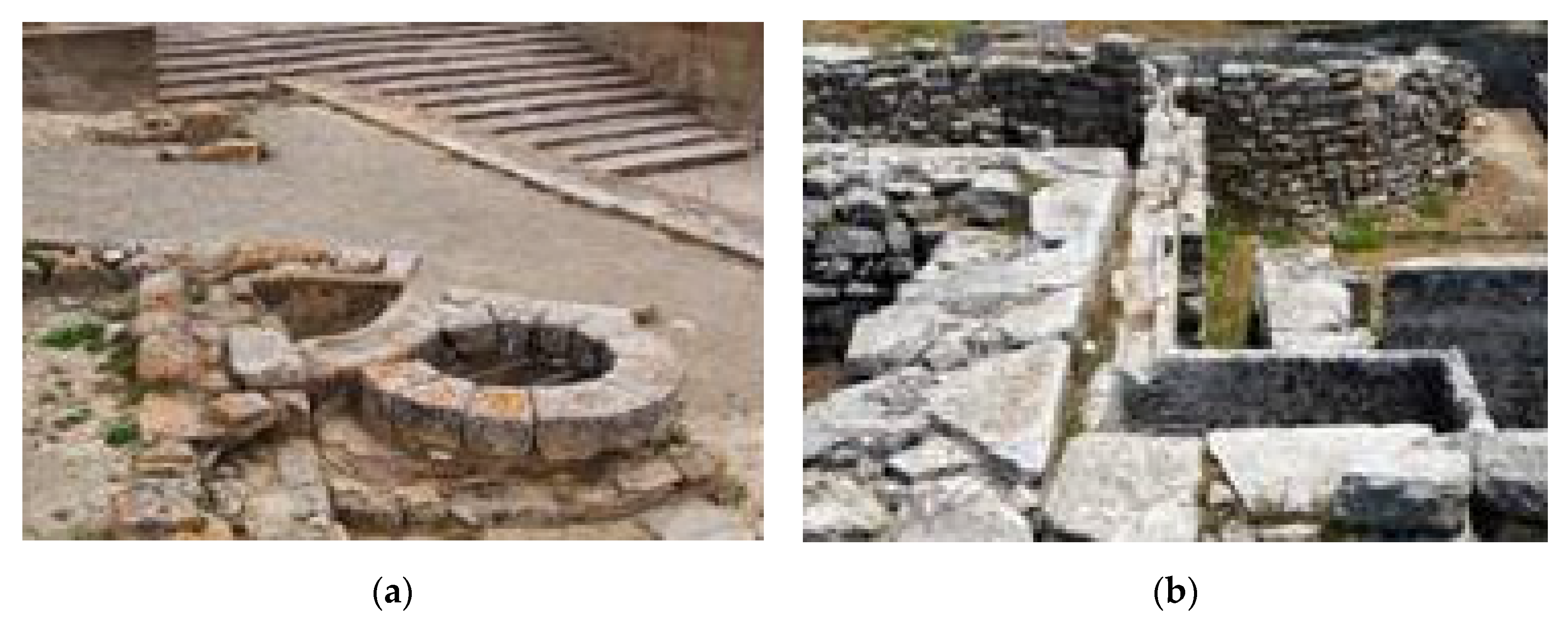


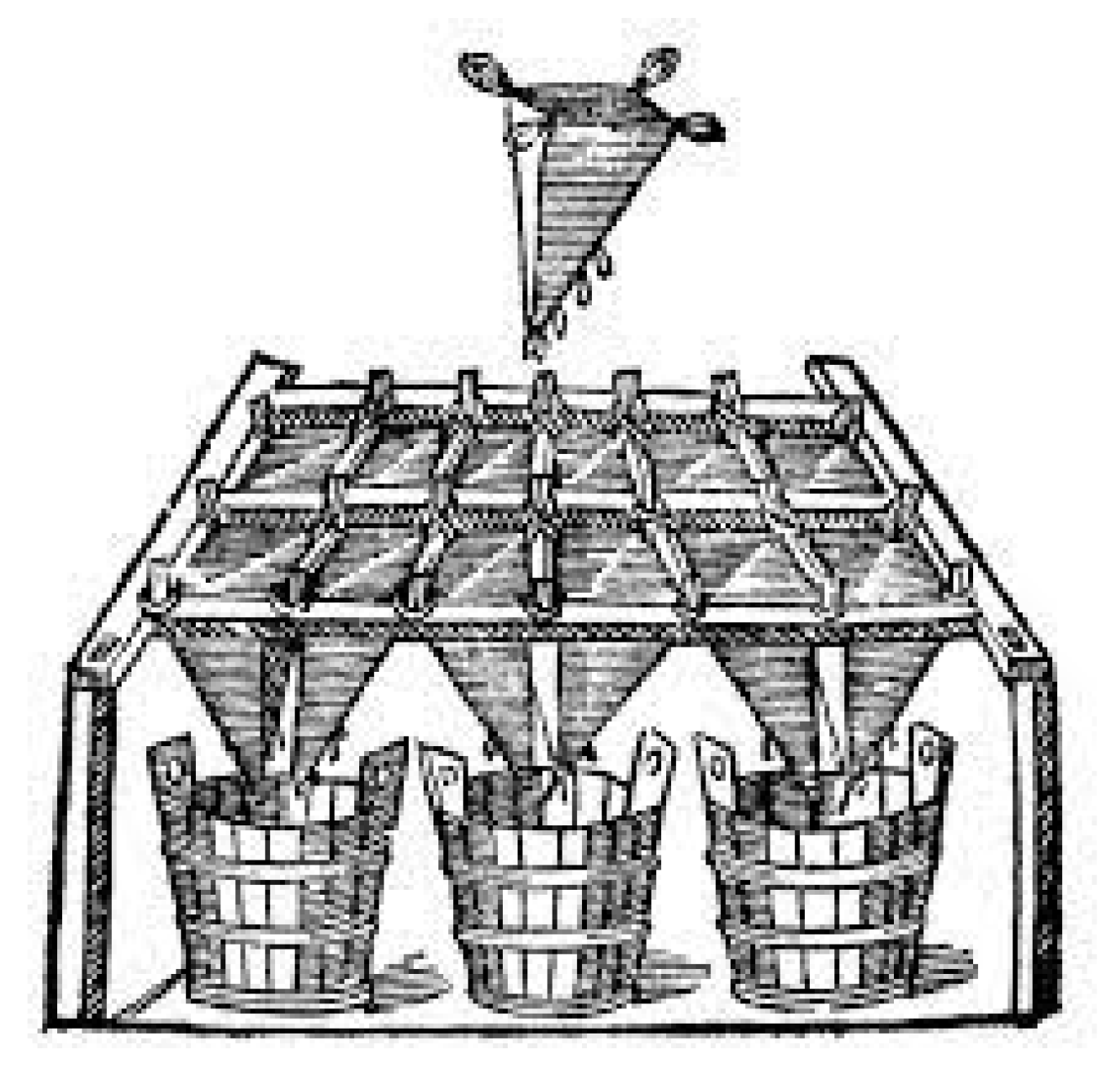
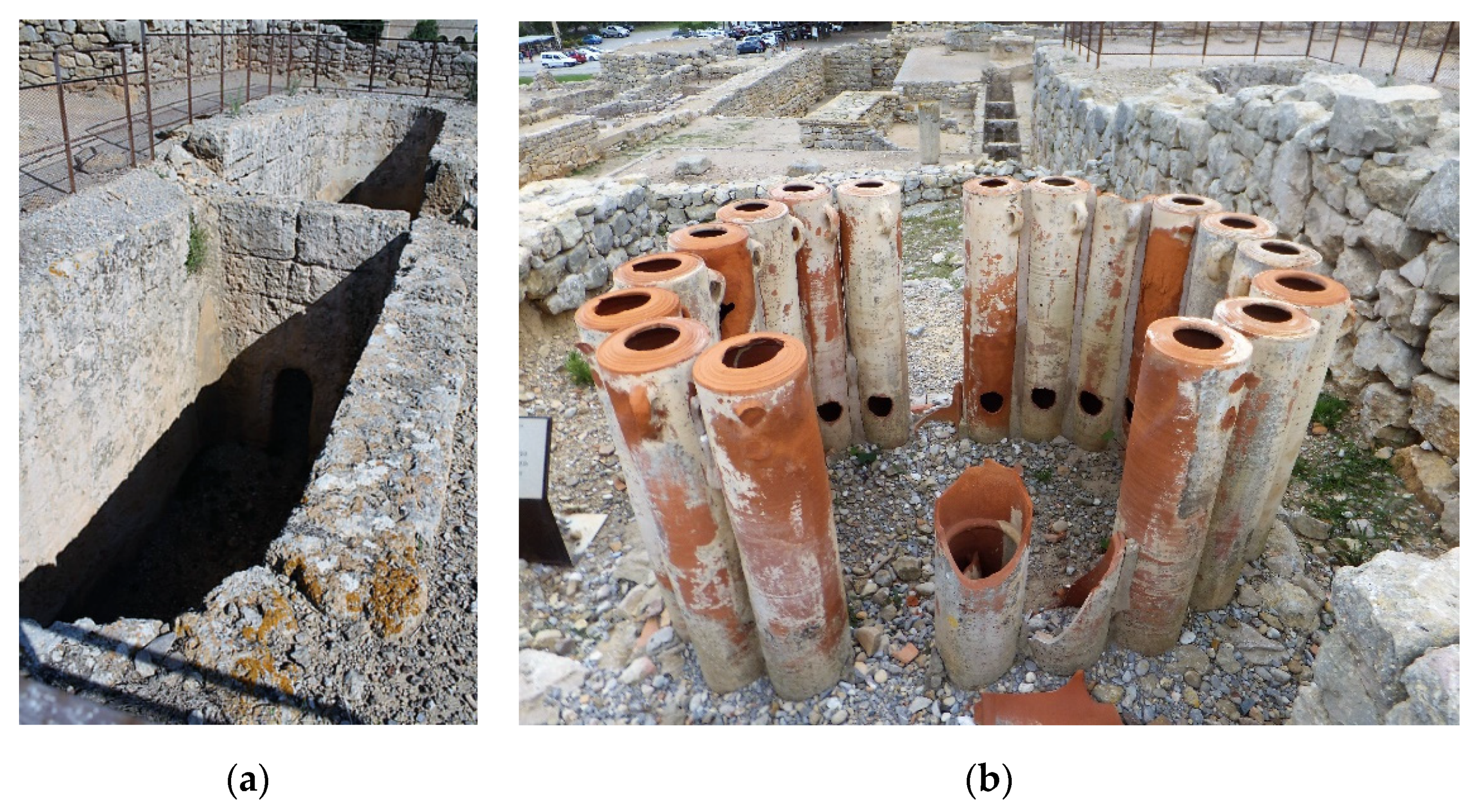
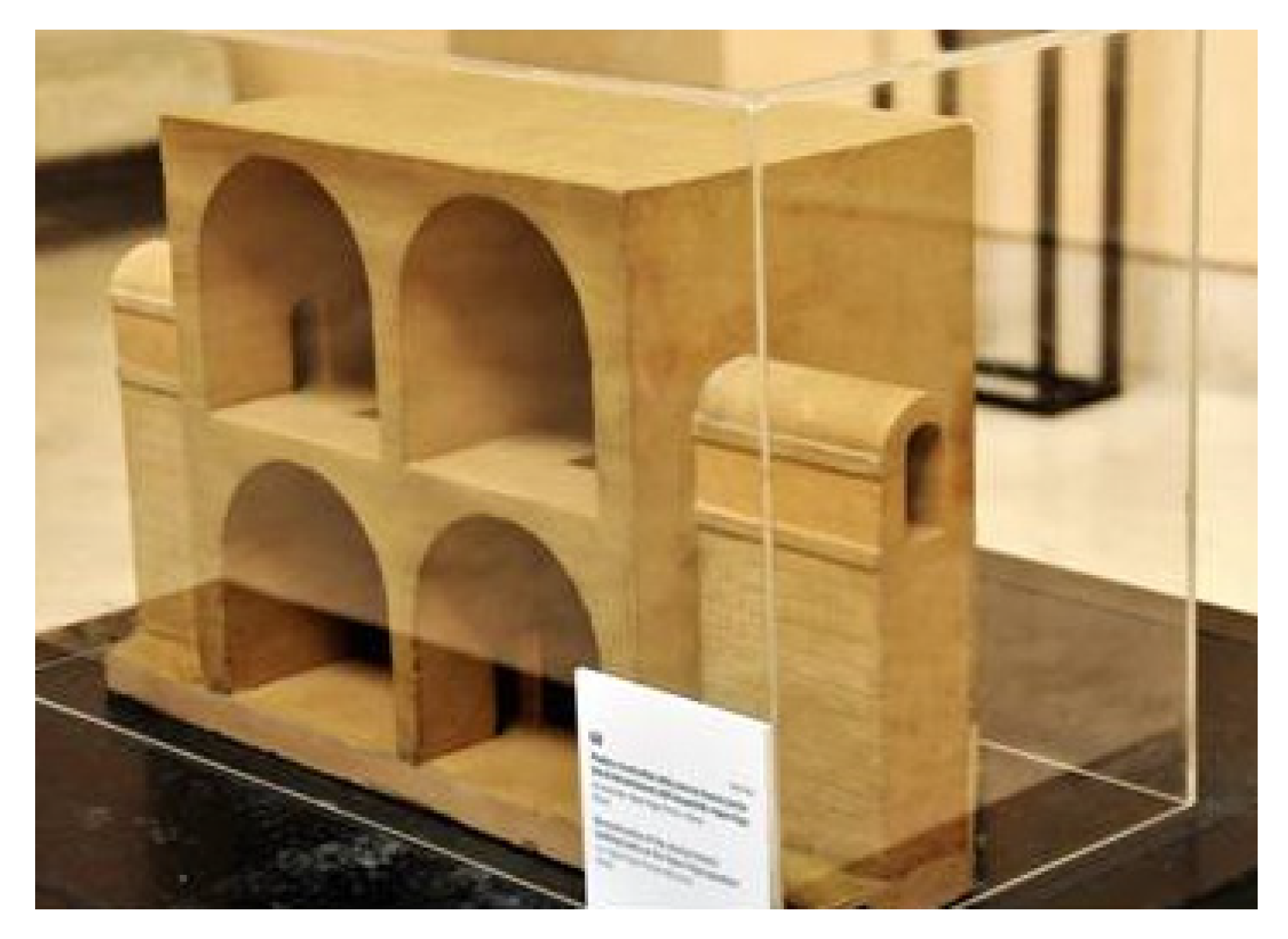
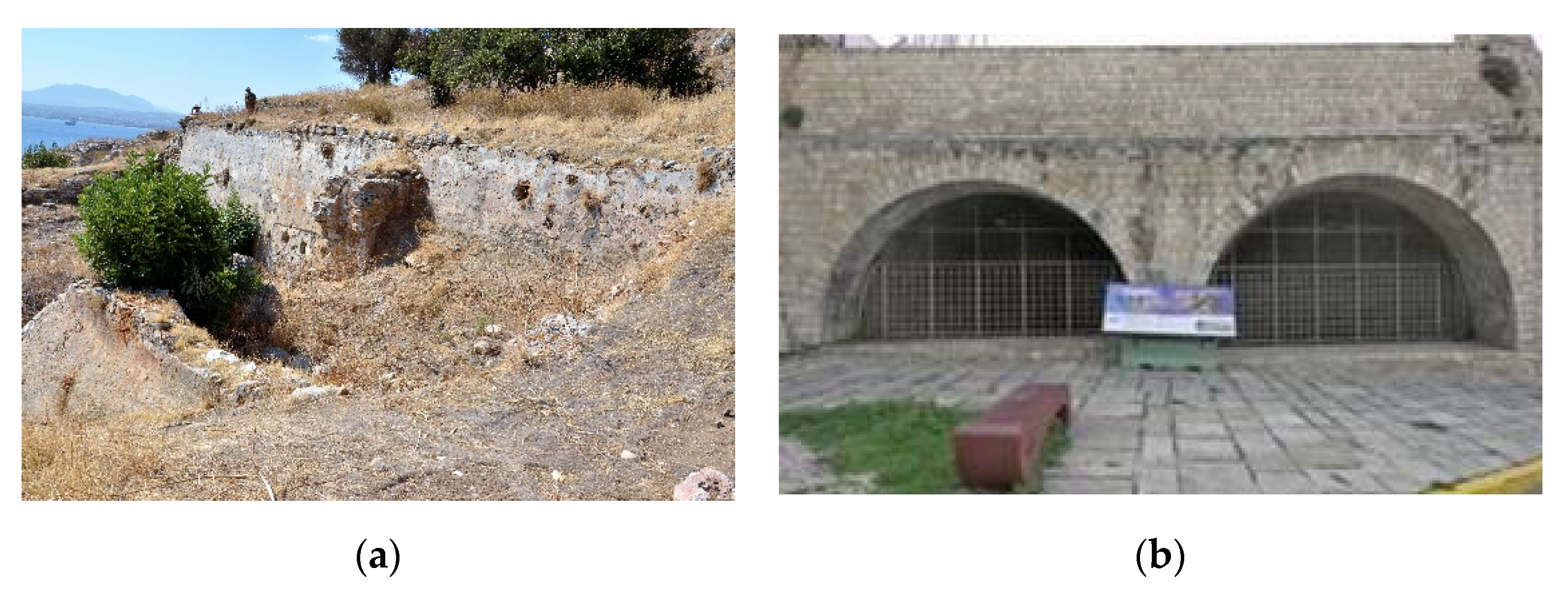


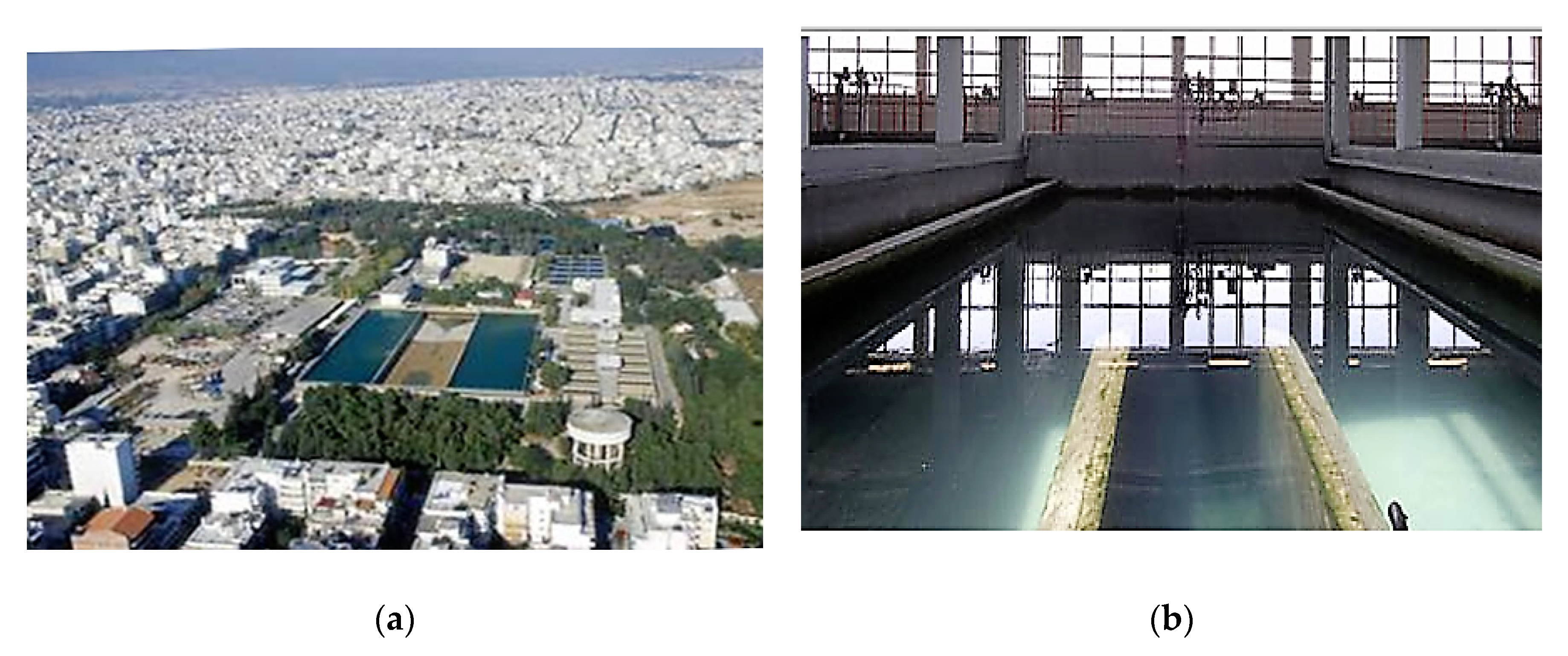
Publisher’s Note: MDPI stays neutral with regard to jurisdictional claims in published maps and institutional affiliations. |
© 2022 by the authors. Licensee MDPI, Basel, Switzerland. This article is an open access article distributed under the terms and conditions of the Creative Commons Attribution (CC BY) license (https://creativecommons.org/licenses/by/4.0/).
Share and Cite
Angelakis, A.N.; Dercas, N.; Tzanakakis, V.A. Water Quality Focusing on the Hellenic World: From Ancient to Modern Times and the Future. Water 2022, 14, 1887. https://doi.org/10.3390/w14121887
Angelakis AN, Dercas N, Tzanakakis VA. Water Quality Focusing on the Hellenic World: From Ancient to Modern Times and the Future. Water. 2022; 14(12):1887. https://doi.org/10.3390/w14121887
Chicago/Turabian StyleAngelakis, Andreas N., Nicholas Dercas, and Vasileios A. Tzanakakis. 2022. "Water Quality Focusing on the Hellenic World: From Ancient to Modern Times and the Future" Water 14, no. 12: 1887. https://doi.org/10.3390/w14121887





